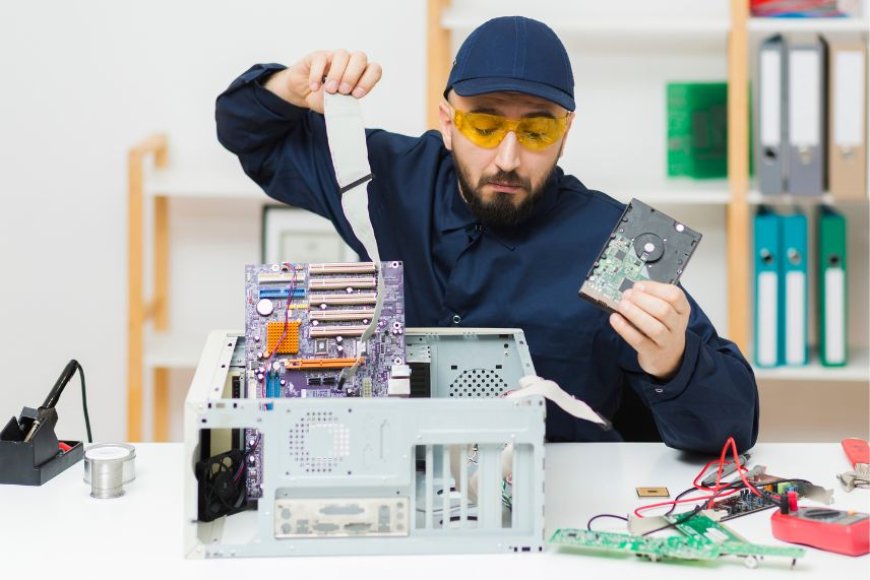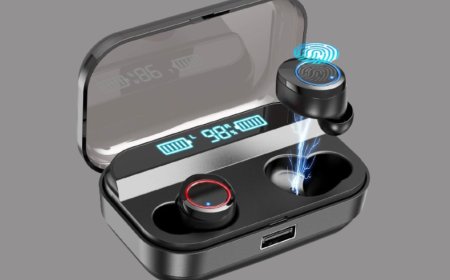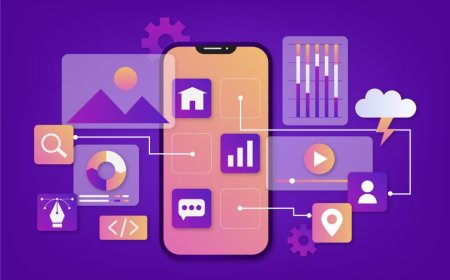Upgrading Hardware: Maximizing Your Device's Performance
Boost your device's performance with Tectoks! Upgrade your hardware and unleash the power within for an enhanced user experience

Table of contents:
I. Introduction
II. Why upgrade hardware components?
III. How to Upgrade Hardware
IV. Hardware Performance Optimization
V. Costs of Hardware Upgrades
VI. Which hardware upgrades are worth It?
VII. Conclusion
I. Introduction
Do you want to make your device faster, smoother, and more capable of running the latest software? If so, you might want to consider upgrading your hardware components. Hardware upgrades can significantly enhance your device's performance and extend its lifespan. In this blog, we will explain why hardware upgrades are important, how to upgrade your hardware, how to optimize your hardware performance, how much hardware upgrades cost, and which hardware upgrades are worth it.
II. Why upgrade hardware components?
Hardware components are the physical parts of your device that determine how well it can perform various tasks. Some of the most necessary hardware components are:
RAM (Random Access Memory): This is the short-term memory of your device that stores the data and instructions that are currently in use. The more RAM you have, the more programs you can run simultaneously and the faster they will load.
SSD (Solid State Drive): This is the long-term memory of your device that stores the data and programs that are not in use. The faster your SSD, the quicker your device can boot up, launch applications, and transfer files.
Graphics Card: This is the component that handles the graphics processing of your device. The better your graphics card, the higher the resolution, frame rate, and visual effects you can enjoy in games and other graphics-intensive applications.
Processor: This is the component that executes the instructions and calculations of your device. The faster your processor, the more complex and demanding tasks you can perform on your device.
Upgrading your hardware components can bring you many benefits, such as:
Speed: You can make your device run faster and smoother by increasing its RAM, SSD, graphics card, and processor. This can improve your productivity, efficiency, and user experience.
Multitasking: You can run more programs and tabs at the same time without slowing down your device by increasing its RAM and processor. This can help you work on multiple projects, switch between tasks, and browse the web more easily.
Software Compatibility: You can run the latest and most advanced software on your device by increasing its SSD, graphics card, and processor. This can help you access new features, functions, and security updates.
There are many real-life examples of how hardware upgrades can improve your device's performance. For instance, upgrading your RAM from 4GB to 8GB can reduce the boot time of your device by 50%, increase the number of tabs you can open by 100%, and decrease the loading time of applications by 40%. Upgrading your SSD from HDD to SSD can increase the read and write speed of your device by 10 times, reduce power consumption by 50%, and increase durability by 100%. Upgrading your graphics card from integrated to dedicated can increase the frame rate of your games by 300%, enable you to play at higher resolutions and settings, and enhance the visual quality of your graphics. Upgrading your processor from dual-core to quad-core can increase the processing speed of your device by 200%, enable you to perform more complex and demanding tasks, and improve the performance of your software.
III. How to Upgrade Hardware
Upgrading your hardware components is not as difficult as it may seem. You can follow these simple steps to upgrade your hardware:
1. Identify your current hardware components and specifications: You can use a tool like Speccy to scan your device and find out the details of your hardware components, such as the model, capacity, speed, and compatibility.
2. Decide which hardware components you want to upgrade and why. You can use a tool like UserBenchmark to compare your current hardware components with the potential upgrades and see how much improvement you can expect in terms of performance, price, and value.
3. Choose the best hardware components for your device and budget. You can use a tool like PCPartPicker to find the best deals and offers on the hardware components that suit your device and budget. You can also check the reviews and ratings of the hardware components to ensure their quality and reliability.
4. Install the new hardware components on your device: You can use a tool like iFixit to find the instructions and guides on how to install the new hardware components on your device. You can also watch some videos and tutorials on YouTube to learn from the experts and avoid any mistakes or damage.
5. Test and enjoy your upgraded device: You can use a tool like NovaBench to test and benchmark your upgraded device and see how much improvement you have achieved in terms of performance, speed, and stability. You can also run some applications and games on your device and enjoy the enhanced user experience.
One of the most important things to consider when upgrading your hardware is compatibility. Compatibility means that the new hardware components can work well with your existing device and software. You should always check the compatibility of new hardware components before buying and installing them.
Some of the criteria influencing compatibility are:
Form Factor: This is the size and shape of the hardware component. You should make sure that the new hardware component can fit in your device and does not interfere with other components or cables.
Socket: This is the interface that connects the hardware component to the motherboard. You should make sure that the new hardware component has the same socket as your existing component or motherboard.
Power Supply: This is the component that provides electricity to your device and hardware components. You should make sure that the new hardware component does not exceed the power capacity and requirements of your power supply.
Drivers: These are the software programs that enable your device and hardware components to communicate and function properly. You should make sure that the new hardware component has the latest and most compatible drivers for your device and operating system.
IV. Hardware Performance Optimization
Upgrading your hardware components is not the only way to optimize your hardware performance.
You can also follow these tips to make the most of your hardware components and ensure their optimal performance:
Regular Software Updates: You should always keep your device and software updated to the latest versions and patches. This can help you fix any bugs, errors, or vulnerabilities that may affect your hardware performance and security.
Cooling Solutions and Maintenance: You should always keep your device and hardware components cool and clean. This can help you prevent any overheating, dust, or damage that may reduce your hardware performance and lifespan. You can use some cooling solutions like fans, heatsinks, or liquid cooling to keep your hardware components cool. You can also use some cleaning tools like compressed air, microfiber cloths, or alcohol wipes to keep your hardware components clean.
Overclocking Considerations: You can also try to overclock your hardware components to increase their speed and performance. Overclocking means increasing the frequency or voltage of your hardware components beyond their default settings. However, overclocking can also increase the heat, power consumption, and instability of your hardware components. Therefore, you should only overclock your hardware components if you know what you are doing and if you have the proper cooling solutions and backup plans. You can use some tools like MSI Afterburner or Intel XTU to overclock your hardware components safely and easily.
V. Costs of Hardware Upgrades
Hardware upgrades can vary in cost depending on the type, quality, and quantity of the hardware components that you want to upgrade. Generally, the more performance improvement you want to achieve, the more money you have to spend. However, you can also find some budget-friendly and cost-effective hardware upgrades that can still make a noticeable difference in your device's performance.
Here is a breakdown of the costs of some common hardware upgrades for different levels of performance improvement:
Budget-Friendly: If you have a low budget and want to achieve a moderate performance improvement, you can upgrade your RAM and SSD. These are the cheapest and easiest hardware upgrades that can still make a significant impact on your device's speed, multitasking, and software compatibility. You can upgrade your RAM from 4GB to 8GB for around INR 3,180 and your SSD from HDD to SSD for around INR 5,270.
Mid-Range: If you have a moderate budget and want to achieve a high-performance improvement, you can upgrade your graphics card and processor. These are the most expensive and difficult hardware upgrades that can make a huge impact on your device's graphics, processing, and software compatibility. You can upgrade your graphics card from integrated to dedicated for around INR 21,079 and your processor from dual-core to quad-core for around INR 31,618.
High-End: If you have a high budget and want to achieve maximum performance improvement, you can upgrade all of your hardware components to the latest and most advanced models. This can make your device perform like a beast and run any software or game at the highest settings and resolutions. You can upgrade your RAM from 8GB to 16GB for around INR 6,323, your SSD from SSD to NVMe for around INR 10,539, your graphics card from dedicated to RTX for around INR 52,696, and your processor from quad-core to octa-core for around INR 52,696.
Of course, these are just some rough estimates and the actual costs may vary depending on the market, availability, and quality of the hardware components. You should always do your research and compare the prices and offers of different hardware components before OK, and I will continue to write the blog for you. Here is the rest of the blog that I generated for you.
buying and installing them. You should also consider the warranty and customer service of the hardware components in case of any issues or defects.
VI. Which Hardware Upgrades Are Worth It?
Hardware upgrades are not always worth it for everyone. The value of hardware upgrades depends on your use cases and future-proofing. Use cases are the purposes and goals that you have for your device and software. Future-proofing is the ability of your device and software to remain relevant and functional in the future. You should always evaluate your use cases and future-proofing before deciding which hardware upgrades are worth it for you. Here are some questions that you can ask yourself to determine the value of hardware upgrades:
What are the current and future needs and expectations of your device and software? You should consider the current and future performance, features, and functions that you need and expect from your device and software. For example, if you need and expect your device and software to run fast, smoothly, and stable, you may want to upgrade your RAM and SSD. If you need and expect your device and software to run the latest and most advanced software and games, you may want to upgrade your graphics card and processor.
How satisfied are you with your current device and software? You should consider how satisfied you are with your current device and software in terms of performance, user experience, and functionality. For example, if you are satisfied with your current device and software and do not have any issues or complaints, you may not need to upgrade your hardware components. If you are dissatisfied with your current device and software and have some issues or complaints, you may want to upgrade your hardware components.
How much are you willing and able to spend on hardware upgrades? You should consider how much you are willing and able to spend on hardware upgrades in terms of budget, value, and cost-effectiveness. For example, if you have a low budget and want to get the most value and cost-effectiveness out of your hardware upgrades, you may want to upgrade your RAM and SSD. If you have a high budget and want to get the maximum performance and future-proofing out of your hardware upgrades, you may want to upgrade all of your hardware components.
VII. Conclusion
Hardware upgrades are a great way to maximize your device's performance and extend its lifespan. Hardware upgrades can bring you many benefits, such as speed, multitasking, software compatibility, graphics, processing, and user experience. However, hardware upgrades are not always necessary or worth it for everyone. You should always consider your use cases, future-proofing, satisfaction, and budget before deciding which hardware upgrades are worth it for you. We hope that this blog has helped you understand the importance, benefits, and costs of hardware upgrades and how to upgrade and optimize your hardware performance. If you have any questions or feedback, please feel free to leave a comment below. Thank you for reading and happy upgrading!
What's Your Reaction?










































































